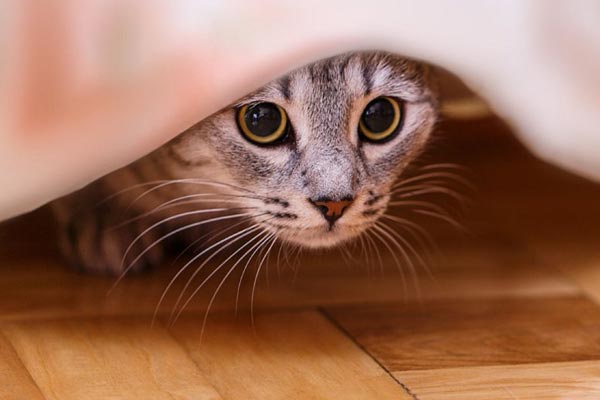
Cat Behaviour Problems: Why does my cat drive me crazy? Should I get 1 more? Ahhhh, the secret life of cats and the things they do that we don’t understand. The behavior of cats can be mysterious and adorable. It can enthrall us and drive us up the wall.
It is the negative behaviors our cats sometimes exhibit that can present challenges that leave us questioning our decision to get a cat in the first place.
Most Common Behavioral Problems In Cats
When the unique personality of the cat combines with the unique dynamics of the home and family the cat lives with, it can create problem behaviors that need to be corrected in order for the ultimate goal of a long-term happy cat-people relationship to result.
If the naughty antics of your best feline friend are leaving you feeling frantic, please know that you aren’t alone in your frenzied state of frustration.
Cat owners the world over are seeking advice, support, and camaraderie from others whose cats are exhibiting destructive, annoying, or otherwise undesirable behaviors.
One has to look no further than a popular forum for cat owners on thecatsite.com, where folks unload their kitty-related grievances in posts like “Kitty on Counters”, “Cat Being a Bully”, “Kitten Peeing in My Bed” and “Catitude!” to know that they are not alone in their dissatisfaction with the undesirable and distressing behaviors their cats are displaying.
Here we will address some of the most common behavior problems of the cats we love and share some resources that will help us get to the bottom of these negative behaviors.
We will also look at some tips and tricks that will be helpful as we attempt to correct our cats’ problem behaviors before they get the best of us.
We all want to live harmoniously with our cats and with some understanding and patience, a little work on our parts, and a lot of love and understanding, that is entirely possible in almost every situation.
They call it “elimination” but it just stinks
The bad behavior cat owners understandably complain about the most is their cat urinating or defecating outside of their kitty litter box. Some cats even specifically select a certain piece of furniture or item of clothing in their home to do their nasty business on.
Obviously, having the mess of cat feces or urine to deal with is a huge source of stress for the cats’ owners. It also presents health and safety issues in the home and is a problem behavior that is almost intolerable due to having to deal with the mess and the smell.
This is something that often causes pet owners who love their cats to surrender them to animal shelters, breaking the hearts of the owners and the spirit of the cat.
While it doesn’t go into a great amount of detail regarding possible solutions to this problem behavior, the website MERCK MANUAL offers some insight into this problem and gives three potential reasons for it: litter box aversion, substrate preference (the preference for a particular type of surface) and location preference.
The cause of this behavior could also be a health issue or the result of stress the cat is experiencing for some reason.
The American Society for the Prevention of Cruelty to Animals provides in-depth information about elimination issues in cats and presents us with a long list of tips to try to help us put an end to this problem behavior.
Some of their ideas include moving the cat’s food and water to a location in your home that is far from the kitty litter and giving positive attention to your cat near his litter box. You might experiment with different brands of cat litter until you find one your cat seems to prefer.
Because some cats are territorial and don’t like to share their litter box with other cats, experts suggest using multiple litter boxes in various locations if you have more than one cat.
Some Veterinarians and pet owners swear by using one litter box per cat and scooping each one daily, saying that this reduces or even gets rid of this problem behavior completely.

Attack Cat!
Sometimes a cat will appear to be just plain mean and act aggressively every time they encounter a human, whether it be a family member or a stranger.
They may act completely unfriendly, defensive, and anti-social, scratching, biting, hissing, growling, and being completely unapproachable whenever they encounter a human.
This problem behavior is highly unusual and it is very unlikely that you have a cat that is just mean at heart. There are very likely other reasons for the behavior.
The very first thing you should do is take your cat to your veterinarian to rule out pain or sickness as the root cause of your cat’s unfriendly behavior. Urinary tract issues or other painful health problems could be the cause of your cat’s aggression.
Once your Vet gives your cat a clean bill of health, don’t be too discouraged if your cat continues to spit and arch his back every time someone speaks to him.
According to the website of the Animal Humane Society, there is help available for understanding the possible reasons for your cat’s aggressive behavior and steps you can take to help reduce her aggression and maybe eventually eliminate it entirely.
According to their website, there are several reasons for aggression in cats including fear and changes or stress within the home setting.
This could include the addition of a new family member such as a new baby or another relative moving in, the addition of another pet, or any sort of change to the environment that he isn’t adjusting well to.
It is difficult to determine the exact cause of a cat’s aggressive behavior but a safe environment with routine attempts at cat-owner interactive play and plenty of variety of toys for the cat is one suggested solution.
A safe and quiet place for your cat to go, away from the hustle and bustle of the household routine is always a good idea. Experts caution against ever leaving an aggressive cat alone with young children.
If your cat is aggressive with other animals, make sure you never attempt to pull apart two animals that are fighting. Break up the brawl by squirting them with water or gently separating them with a broom but don’t put yourself into the mix as it could be very dangerous for you.
A consultation with a Veterinary Behaviorist is sometimes a necessary first step to getting to the bottom of why your kitty’s behavior is the direct opposite of being loving and friendly and taking steps to correct this problem behavior.
Party All Night, Sleep All Day
According to Web MD’s site for pet health, the night behavior of cats may be in their DNA. Your cat’s genetic relatives – the cheetah, mountain lion, and others are known, as nocturnal hunters.
Another main reason that your cat may keep you awake with his nighttime antics or try to wake you up at random times during the night for a snuggle or play session is a desire for your company.
It is very important to address this problem behavior and get it corrected as a frisky cat could unintentionally injure its owner or another household member by scratching them while they are sleeping.
It is suggested that you keep your cat as busy as possible during day and evening hours by providing a variety of stimulating toys. You might even want to consider waking your sleeping cat up for some play or a few treats.
A window with a view to the great outdoors where your cat can perch to watch birds or squirrels at a feeder is another way to keep her stimulated when you aren’t around to play and interact with her.
Why my cat is driving me crazy at night
It is recommended that a family member schedule a few interactive play sessions with your cat after dinner each evening. This will provide the stimulation and attention she craves from you and helps tire her out.
Because cats have a tendency to go to sleep after a big meal, is suggested that feeding your cat her main meal of the day just prior to bedtime might help her to sleep for longer stretches of time throughout the night, reducing her nocturnal disruptions of your sleep.
A timed feeder can be used to get your cat used to having her favorite snack dispensed at 3:00 a.m., keeping her too busy to bother you while you’re asleep.

Scaredy Cat!
Some cat owners come to be very disappointed when they discover that the cat they got for company and interaction isn’t so enthused about being an involved part of the family and spends most of his time in hiding.
After all, we didn’t get a cat so we could never see her. We want to spend time with our cat and form a bond with him. These cats often hide so well that they won’t be found until they are ready to be seen again.
If visitors to your home are asking “what cat?” when you want to show off your feline friend to them, this YouTube video provides some good advice about how you can help a cat who is fearful and avoids interaction.
Hopefully, with time and some serious commitment on the part of her human family to play hard to get, your cat will become less afraid and will start to seek out your company on her own and also warm up to your family members and visitors to your home.
Cat Scratch Fever!
Your expensive drapes, your child’s backpack, your leather coat, the sofa you spent a small fortune on – all of these are items you need to protect from the razor-sharp claws of your cat.
Scratching of furniture and other household items is a huge complaint of cat owners who site this behavior as the main reason for not keeping their beloved pets.
Cats have an instinctive need to scratch for multiple reasons, one of which is to keep their claws sharp. They also scratch because it is an excellent way for them to work off some of their natural kitty energy. Other reasons cats scratch, according to PurrfectPost, include the instinctive need to stretch out.
Scratching is also another way that cats mark their territory, as there are scent glands in their paws that release odors onto the item they are scratching.
You can’t stop them from scratching but according to American Humane, you can stop them from scratching your cherished household possessions.
Trying different types of scratching posts with catnip sprinkled on and around them may entice your cat to scratch on those instead of your new slipcovers.
Some pet owners have had success with placing a towel over the surface they don’t want the cat to scratch and sprinkling it with black pepper or peppermint oil.
Declawing your Cat To Calm your Feline
Declawing your cat is never recommended as a solution to this problem behavior and many Vets won’t perform the procedure anymore as the practice is considered inhumane.
The scientifically proven benefits of owning a cat far outweigh the negatives. From lowering your risk of heart disease to reducing stress and anxiety, having one or more cats is proven to be good for both our mental and physical health.
The American College of Veterinary Medicine provides a host of resources for understanding the behavior of cats.
The Cat Friendly website provides an entire page of information regarding why cats behave the way they do and addresses all of the problem behaviors we have discussed here along with several other problem behaviors.
With so much help and so many resources available (websites, Veterinarians, Cat Behaviorists) to assist us with reducing or eliminating the problem behaviors of our feline family members, there is no reason to despair and every good and wonderful reason for you and your beloved cat to live a long, happy, healthy life together.

Hi, This is Alexa, and I love cats. This Website is a Complete Journal about how to travel with a cat and other information about Cat Health, Cat Training, Cat Behavior, Cat Foods and more. I hope you find it useful.
